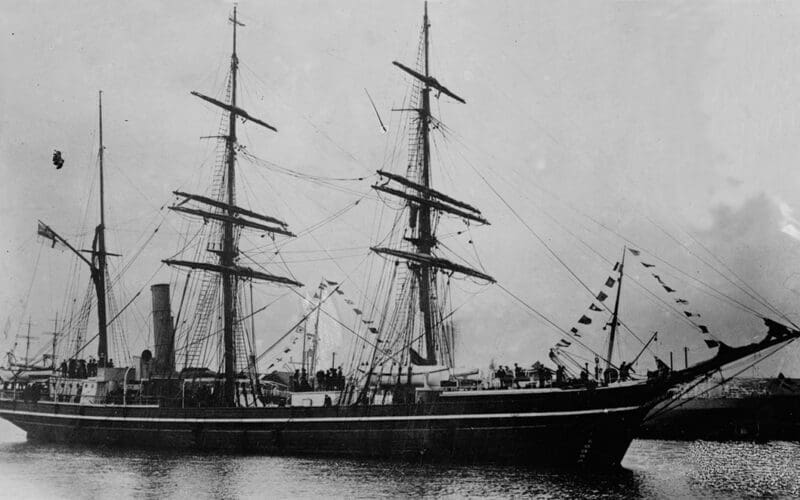
sea ice.
Best remembered as the ship that carried Robert Scott on his ill-fated voyage to the Antarctic in 1910, Terra Nova (new land) survived the harshest sea conditions for almost six decades before meeting her end. The three-masted barque, built in Dundee, Scotland, in 1884 by Alexander Stephens and Sons, was 664 tons and 187 feet long. Beginning life as a steam-auxiliary sailing ship, Terra Nova worked first as a whaler in the Arctic and then in the more profitable business of hunting seal pups for their furs. It is estimated that in her career as a sealer, Terra Nova carried more than 800,000 seal pelts — a bloody business.
The ship first went to the Antarctic in 1903 to rescue Scott’s ship Discovery from the pack ice in McMurdo Sound. In preparation for his return to the Antarctic, Scott purchased Terra Nova for £12,500. The ship was reinforced with seven feet of oak to protect the bows and steel plating to reinforce the stem. Scott described the ship as “a wonderfully fine ice ship … as she bumped the floes with mighty shocks, crushing a way through some, twisting and turning to avoid others, she seemed like a living thing fighting a great fight.”
Scott used Terra Nova at Ross Island as part of his base camp. The ship itself had a crew of 65 and Scott’s team consisted of 24 officers and scientific staff.
The purpose of Scott’s effort, called the British Antarctic Expedition, was for the British to arrive at the south pole first.
Unfortunately, the Norwegian explorer Roald Amundsen arrived at the pole a month before Scott and his five-member team. On the way back to base camp, Scott and his men perished, Scott and two of his companions dying only 11 miles from the nearest food depot.
Terra Nova went back to the Arctic carrying cargo in World War I for the Canadian government and then hauling cargo for the Americans in Greenland during World War II. In 1942, off of Greenland, the ship struck ice and sank. The USCG mounted a rescue operation and all 24 crewmembers were saved. The wreck was accidentally rediscovered in 2012. Before sinking, the ship’s bell was saved and is kept at the Scott Polar Research Institute. The bell is struck at 16:00 hours daily, announcing a coffee break and afternoon tea — five bells in the AM and eight bells in the afternoon.
Let’s join Captain Henry Pennell on the way from Cardiff, Wales, in 1910 to South Africa to pick up Captain Scott. We’ll use the 2020 Nautical Almanac.
It is July 3 and we are at a DR of 5° 18’ south by 15° 12’ west. Height of eye is 20 feet. At 04:30:12 GMT, the navigator has clear sky to take a shot of Saturn. The Hs is 55° 10.8’.
A. What is the HO of Saturn?
B. What is the LHA?
C. What is the intercept?
D. What is the estimated position?
Answers
A. 55° 6.3’
B. 032°
C. 5.3 nm toward
D. 5° 15’ south, 15° 10’ west

